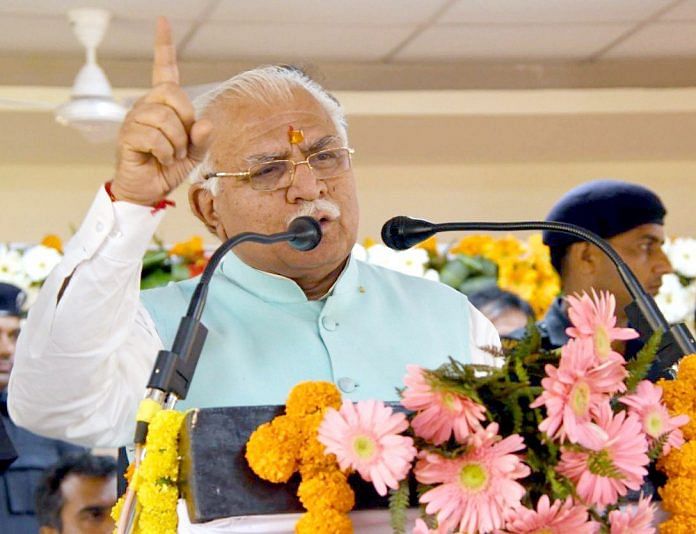Chandigarh: With Haryana set to vote on 21 October, the ruling Bharatiya Janata Party (BJP) is hoping to repeat its historic 2014 performance when it came to power in the state on its own for the first time, winning 47 of the 90 assembly seats.
Coming just months after the BJP made a clean sweep in the state during the Lok Sabha elections, the Manohar Lal Khattar-led state unit holds a definite edge over its contenders in the upcoming polls as the opposition parties face internal challenges to put up a real fight.
The BJP’s main rival Congress only just got its act together after the inertia-ridden party high command gave election responsibilities to former chief minister Bhupinder Singh Hooda, who led the state for 10 years before losing in 2014.
The ‘Modi factor’, which has propelled the party in Haryana, has helped the party dominate almost every election in the last five years — panchayat, municipal bodies, mayoral or assembly bypolls.
The same will play the most crucial role this time as well, even as the BJP looks to ward off the electoral impact of the Narendra Modi government’s poor economic performance.
Also read: Amit Shah has more to prove than Modi in Maharashtra and Haryana assembly elections
The Haryana ascent
In 2014, from barely having anything to show for in the state, the BJP rode the massive Modi wave to come to power in the state. Manohar Lal Khattar, a first-time MLA was named chief minister. The non-Jat leader was given the charge of a state dominated by Jats and for decades oscillated between the Congress and the Indian National Lok Dal (INLD).
Jats constitute almost 28 per cent of the total population in the state. But the BJP’s successful experiment of consolidating the not-Jat vote block broke the hegemony.
Now, five years later, Khattar has made his mark on the state.
During his tenure, he has offered corruption-free governance, and focused particularly on transparency in government recruitment. Learning another lesson from the fate of his predecessors, Khattar steered clear of land acquisitions and large real estate projects, something Haryana become synonymous with during the Hooda regime.
Khattar’s personal rapport with PM Modi also ensured that all major flagship projects and schemes of the Union government were diligently implemented in Haryana — from Pradhan Mantri Fasal Bima Yojana to Pradhan Mantri Kisan Maan Dhan Yojana, among others.
Khattar’s government has also been true to his RSS background, working towards the organisation’s agendas like cow protection and reviving the Saraswati river in Haryana.
The BJP government has, however, fared poorly in making the state safe for women, struggling to shake off Haryana’s dubious reputation of being the rape capital of the country.
Earlier this month, the Haryana CM travelled through all the assembly constituencies in the state in just 16 days during his ‘Jan Ashirwaad Yatra’.
Internal conflict
The opposition is focusing its campaign on the economic downturn under the Modi government, unemployment, agrarian distress and safety of women as the big issues in the assembly elections, but there are several internal challenges to overcome.
After it was dislodged in 2014, the Congress has remained a sharply divided house in the state. While a majority of its 15 MLAs are with Hooda, there are other power centres too. Former state president Ashok Tanwar and Hooda remain sworn enemies and their mutual enmity has made it difficult for the party to challenge the BJP.
Even with this month’s shake-up in the party, it’s going to be a herculean task for Hooda and the new state unit chief Kumari Selja to halt the BJP’s winning streak.
In 2017, the Jat-dominated INLD began to emerge from the shadows after being out of power for almost a decade. But its undeniable resurgence was short lived after an ugly family feud between former chief minister Om Prakash Chautala’s sons led to a vertical split in the party.
The division dealt a body blow to the INLD, which saw its vote share plunging from 24 per cent in the 2014 Lok Sabha elections to 1.8 per cent this year. Its breakaway group, the Jannayak Janata Party (JJP), could muster only about 6 per cent votes.
A large number of its 19 MLAs subsequently joined the BJP or the Congress, apart from other party leaders who threw their weight behind the JJP. A recent bid by Jat khap panchayats to bring the two units together failed.
While the Aam Aadmi Party remains a non entity in Haryana, the Dalit-dominated Bahujan Samaj Party (BSP) is also struggling in a state that has almost 21 per cent Dalit population. Its bid to forge a pre-poll alliance with the INLD, the JJP or even the Congress has not yielded any results.
Also read: Haryana Congress shake-up has Sonia’s stamp all over — and a peek at where Rahul failed






